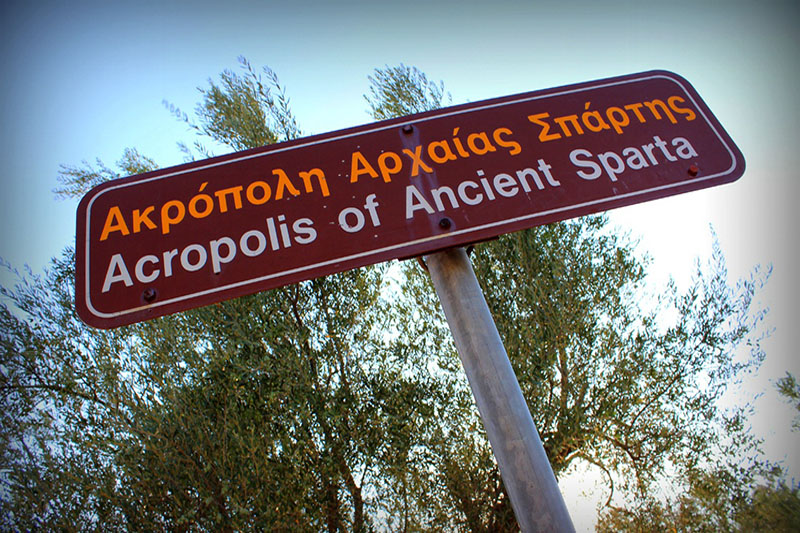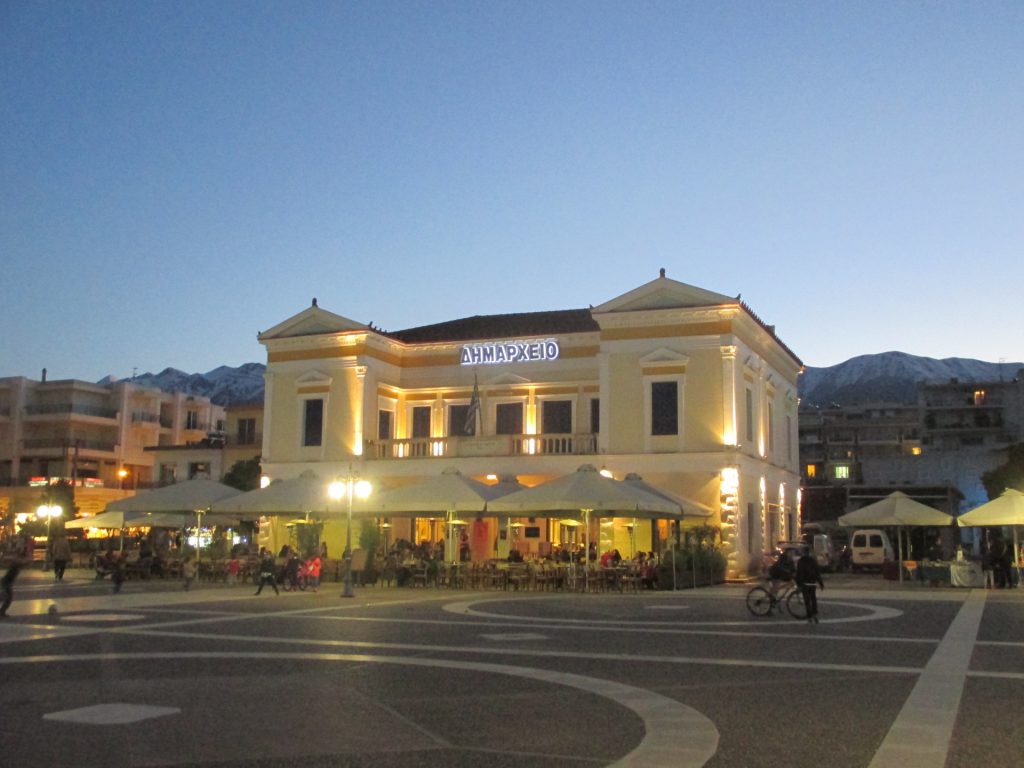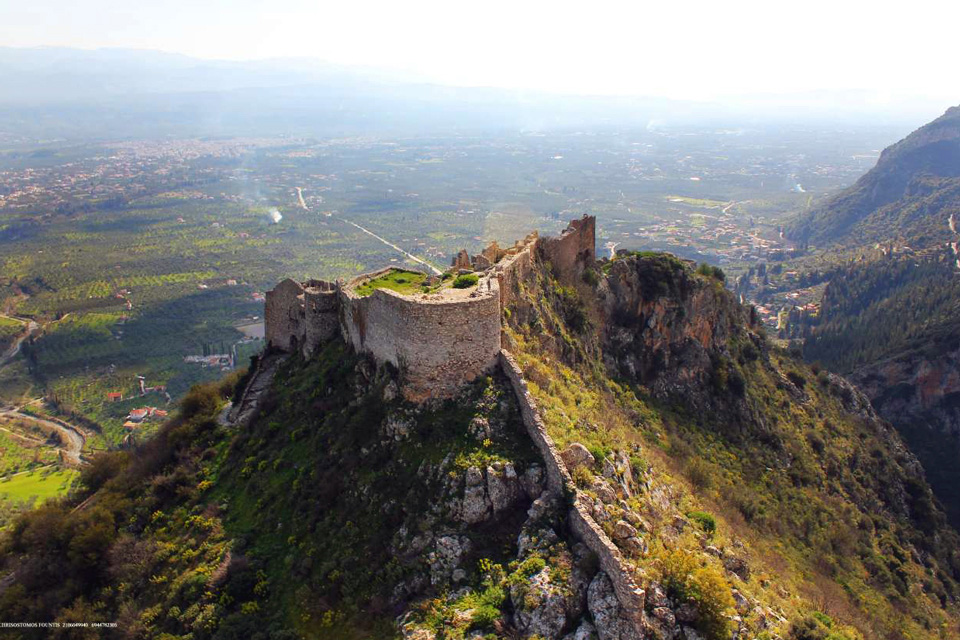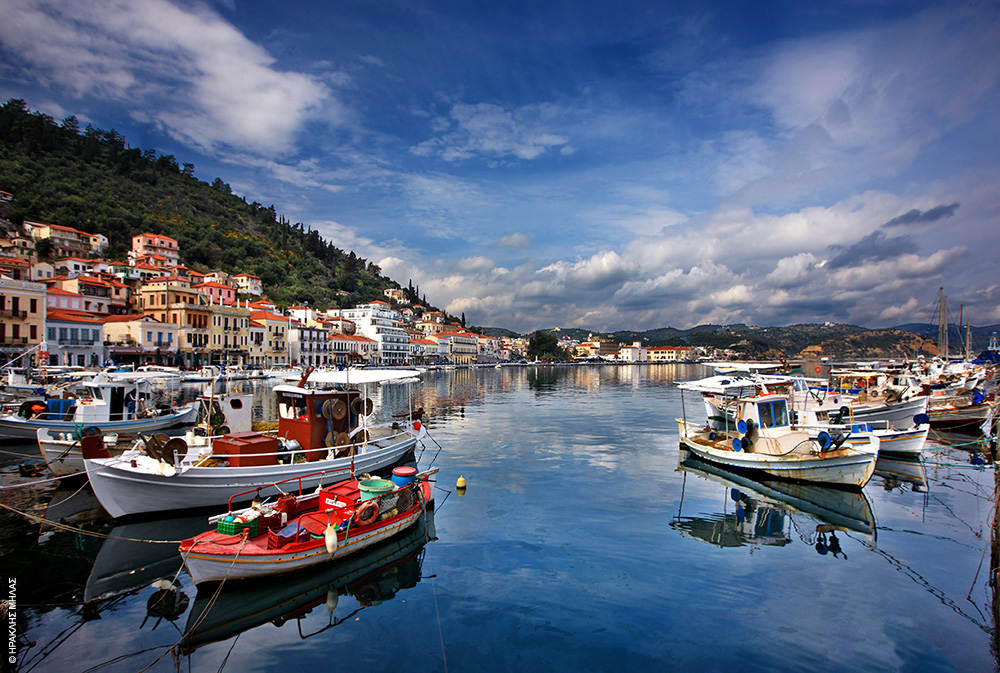DISCOVER SPARTA
Broad streets full of trees, large squares, neoclassical buildings and nice hotels, scented by the olive, orange and lemon trees of the nearby valley of the Eurotas River: this is Sparta! Surrounded by mounts Taýgetos and Párnon, Sparta was the kingdom of Menelaus and his beautiful queen, the most beautiful of all mortal women of her age, Helen.
On the hill of Prophet Elias, just a few kilometers east of Sparta, opposite the Evrotas River, we encounter one of the most significant sanctuaries of Sparta. It is an area with precious Mycenaean relics. After Amykles, Therapnes is the second prehistoric site inhabited since the early Bronze Age. Its name was taken from Therapne, the daughter of King Lelex.
A short distance west of the Mycenaean site in Therapnes, an impressive sanctuary constructed in historical times has been discovered. Here, Menelaos and Helen were worshipped as gods. Excavations conducted by the British School have brought to light a truly odd structure. It is a large pyramidal foundation that rises to the top of the hill and forms a kind of base for the temple. It was built with large, well-carved stones and it has been well-preserved, although we still do not recognize its significance.
This sanctuary succeeded a much older one. At the time of Pausanias, it is believed that Menelaos and Helen were buried there. They were considered gods and sacrifices were made in Therapnes in their honor.
Check the route from Lakonia Hotel by Google Maps
Findings at this archaeological site were unearthed by the pioneer excavations of the British School of Archaeology starting in 1910. Excavations resumed in the early 1990’s, primarily in the areas of the ancient theatre and the merchant stalls.
The most significant monuments of this archeological site include:
The Temple of Athena Chalkioikos whose position has been defined by few surviving relics found at the northwest end of the Acropolis. The temple, designed by the architect Vathyklis from Magnesia, had an interior design adorned with copper sheets (dated 6th century BC onwards) to which it owes its name (chalkioikos = copper). From the inscription by Damononos (dated before 430 BC), it seems it was called Temple of Athena Poliouchos (Guardian of the City). Pausanias adds that the temple was left unfinished until Gitiada, a local craftsman, built both the statue of the goddess and completed the temple. The temple also served as a place of refuge for Lycurgus, Pausanias and Agis IV.
The ancient theater of Sparta on the south side of the Acropolis is a product of the early Imperial Period. The orchestra, the retaining wall with engraved inscriptions of the rulers of Sparta in Roman times and the concave portion of the large theater has been preserved. The concave of the theatre was dug into the southwest end of the Acropolis. The retaining wall of the concave is marble and its east side was engraved in the 2nd century AD with various inscriptions. The theatre was used primarily for public gatherings and celebrations. It had no permanent stage. For theater performances, a wooden, mobile stage equipped with wheels was easily moved into position. Nearly all the findings of the ancient theater that were discovered by the British School of Archaeology date back to the Roman Era.
Check the route from Lakonia Hotel by Google Maps
The hilltop castle nestled on Mt. Taygetos was founded by the Frankish leader, William II of Villehardouin in 1249. The Byzantines became masters of the castle after 1262. In the mid 14th century, the seat of Mystras was the Despot of Morea. In 1448, the last emperor of Byzantium, the despot Constantine XI Palaeologos was crowned here. In 1460, Mystras surrendered to the Turks. In 1464, Sigismondo Pandolfo Malatesta seizes the city, but not the castle. Years later, Mystras falls briefly to the Venetians (1687-1715) and then back under Turkish domination. In 1821, Mystras is among the first areas in Greece to gain independence.
The most significant monuments and architectural ensembles of the area include:
The Fortifications: The Frankish castle with its battlements and towers are the work of William II of Villehardouin. Its walls are arranged in two strong fortified enclosures supported by tall square towers.
The Metropolis (St. Demetrios): mixed architectural style church; a three-aisled basilica with a vestibule and bell tower and inscribed cruciform plan.
The Church of St. Theodore: the work of the monks Daniel and Pachomios; octagonal type with side chapels, built between 1290 and 1295, with frescoes of the late 13th century.
The Hodegetria: work of Father Superior Pachomios in 1310; mixed architectural type, outstanding wall paintings from the period 1312-1322.
St. Sophia: inscribed cruciform domed church, built in the mid-14th century with chapels and a bell tower.
The Monestary Perivleptou: a catholic church with inscribed cruciform plan and a dome. The murals of the church are excellent works by various artists from the third quarter of the 14th century.
Evangelistria: inscribed cruciform church with a dome and frescoes dating back to the early 15th century.
The Monastery of Pantanassa: exceptional wall paintings dated circa 1430, while those found on the ground floor are of the 18th century.
The Palaces of the Despots of Mystras (Kantakouzinos-Paleologos): extensive complex of structures arranged in a Γ- shape, built at different times during the 13th-15th centuries; the complex served various purposes throughout the years.
Check the route from Lakonia Hotel by Google Maps
The Sanctuary of Artemis Orthia was built near the banks of the Evrotas River, near the ancient town of Limnon. It was one of the most significant sanctuaries of the Spartan cult and was associated with the education of young Spartans.
Early on, the deity worshipped was referred to as Orthias who was considered the goddess of salvation and fertility, as well as the protector of vegetation. Later on, the cult was linked to that of Artemis and the temple became a center of religious education for young people. During the Imperial Period, it served as the site of bloody spectacles performed in accordance to the customs of the time.
The temple was excavated by the British Archaeological School of Athens (1906-1910). We can now distinguish three sections: (1) a great Roman structure (during the Imperial Period, the shrine of Orthias had taken the form of a circular amphitheater where the temple held the position of the stage), (2) the remains of an altar in the center of the site and (3) a section of the temple to the west. The temple was built with rough stones in the 6th century BC.
The presence of the impressive amphitheater indicates that people gathered there to observe rituals performed in honor of Artemis Orthia.
From the numerous inscriptions found at the temple, it seems that the goddess was associated with the education of Spartan children under the age of 13.
Below this temple, a smaller, older temple has been discovered which probably dates back to the 9th century BC.
Check the route from Lakonia Hotel by Google Maps
In Amykles, on the hill of Agia Kyriaki, lies the Sanctuary of Apollo Amyklaios. It served as the political and religious center of ancient Sparta from early historical times until the Mycenaean Age. It was at this site that perhaps the most important Spartan feast, the Hyacinth, was held annually in honor of Hyakinthos, a friend of Apollo. Hyacinth was a pre-Hellenic god of vegetation. According to the testimonies of various sources, upon Hyacinth’s tomb, a 13 meter statue of Apollo was erected. Around the mid- second century AD, Pausanias described his awe with this structure and the impressive number of mythological representations that decorated it. For the construction of this brilliant, enigmatic monument in the late 6th century BC, the Spartans called upon the famous architect, Vathykli from Magnesia in Asia Minor.
Check the route from Lakonia Hotel by Google Maps
The Parliament building, which is located in the south-west sector of Syntagma Square,holds a special place in Greek history, as it was here that the parliament of the rebellious Greeks met.
According to Greek archaeologist Christos Tsountas, at the site of the village of Vafeio, about 300 meters north of Paliopyrgos hill, lies the ancient city of Faris.
In 1888, a vaulted Mycenaean tomb was found, containing burial offerings. Among them were two golden cups decorated with relief scenes depicting the hunting of wild bulls. These are now on display at the National Archaeological Museum. The ancient city of Faris was mentioned by Homer and was one of the six cities that made up the archaic Hexapolis of Lakonia.
Check the route from Lakonia Hotel by Google Maps
The most significant discoveries of this archaeological site include:
The Cemetery of Vaulted Chamber Tombs at the site of ‘Spilies’ dating back to the Mycenaean Era. The largest of these chamber tombs was built in the early Mycenaean Era (approx. 1500 BC).
The Acropolis of Pellana, where remnants of Hellenistic walls and relics of the Frankish period have been uncovered.
Atop the Acroplis on ‘Palaiokastro’ hill, recent excavations have unearthed remnants dating back to the Early Helladic period (approx. 2500 BC); this was perhaps a palatial building.
Check the route from Lakonia Hotel by Google Maps
Leonidaion is an ancient, ruined structure also known as “the tomb of Leonidas”. Ancient lore places the tomb of Leonidas in Sparta, opposite the theater, but many dispute this. The structure is a temple-form enclosure with two spaces. Its elaborate, rectangular stone blocks of unusual proportions are quite impressive.
Check the route from Lakonia Hotel by Google Maps
The ‘Hellenic’ Bridge of Rasinas is an important archaeological monument in Xirokambi. It is believed to be the most ancient operating bridge in Europe. It was built by the Spartans in the late 1st century BC when Augustus granted them the harbor of Kardamili. The name ‘Hellenic’ was given to the bridge by the Christians to signify the work done by the ancient Greeks and the inhabitants of the surrounding area of ‘Kamara’. Folk lore associates the bridge with Helen’s flight to Troy. In addition, legend has it that the wife of the bridge’s master craftsman was sacrificed in order to solidify the foundations of the bridge and her restless ghost is said to appear at night.
Check the route from Lakonia Hotel by Google Maps
Mount Taygetos is one of the highest mountains in Greece, boasting a height of 2404 meters. Beautiful forests covering the middle mountain zone, fragrant phrygana shrubs sprinkled in the lower parts of the mountain, gorges and ravines shaded by plane trees are all features of this landscape that will fascinate visitors. Its highest mountain peak, which is also the highest in the Peloponnese, is the Prophet Elias with a chapel of the same name. Every year on the 20th of July, pilgrims and trailblazers alike hike to the top and pay a visit to the chapel.
Other peaks of Mt. Taygetos include Sidirokastro (2340 m), Spanakaki (2024 m), Neraidovouna (2020 m), Goupata (2031 m), Koufovouni (1850 m) and Broken Mountain (2204 m) to name a few.
The eastern slopes of the mountain form many ravines which supply water to the Evrotas River.
The region is part of the Natura 2000 network of habitats and thus, significant infrastructure projects have been initiated for the development of mild ecotourism. Mt. Taygetos has been designated as an ‘Important Bird Area’ of Greece. The central region of Mt. Taygetos has been proposed as a candidate National Park of Greece, as it is a protected area with rare species of plants and animals, while its landscapes and ecosystems are fascinating.
Check the route from Lakonia Hotel by Google Maps
Mount Parnonas or Malevos is lower than Mt. Taygetos, but equally as charming and lush with pine and fir. Its highest peak, the Great Tourla Kronio, stands tall at 1,934 meters. Beautiful plateaus, gorges of wild beauty and deep valleys create a landscape of unparalleled beauty. The Mt. Parnonas range stretches over 100 km, starting from the plateau of Tegea in the north and ending at Cape Malia.
The Oinountas or Kelefina River on the western slopes flows to the Evrotas River near Sparta.
The forests covering Mt. Parnonas are primarily made up of three species of conifers: the fir (Abies cephalonica), the black pine (Pinus nigra) and the rare Dendrokedro Juniper (Juniperus drupacea), as well as oak trees, plane trees and carob trees.
At the border of Arkadia, surrounding the Monastery of Malevi, a large forest of Dendrokedra Junipers has been declared a protected natural monument and is part of the Natura 2000 network.
Check the route from Lakonia Hotel by Google Maps
The Evrotas River source is found in the region of Mantineia in Arkadia. It flows 82 km, receiving water from several tributaries, and finally empties into the Lakonian Gulf, forming a delta. The Evrotas River Delta is one of the last major wetlands in southern Greece.
The banks of the Evrotas River serve as one of the last breeding grounds in the Mediterranean for the Caretta Caretta sea turtle. In the dune area, the largest in the southern Peloponnese, you can encounter rare plant species such as Linum phitosianum, a species unique in all the world.
Visitors can cross the Evrotas River at many points. During the winter when the river flows with plenty of water, many canoe enthusiasts engage in their favorite sport from January to April. The route starts in the region of Vordonia, and you can get there by turning right on the main road after the second small bridge after the village of Karavas. Another access point is in the area of Piri and you can get there by taking the main road from Sparta towards Gytheio and turning left one kilometer after the military camp KEEM where there is a sign for the Airport.
In the wetlands of the Evrotas River, 210 species have been recorded, including waterfowl and raptors.
Despite extensive human disturbance to the area, the wetlands have been designated as an ‘Important Bird Area’ by the Greek Ornithological Company, which operates the Environmental Station of the Evrotas River just south of Skala on the way to Leimona. Access is easy from the main road Gytheio-Neapoli. For information and excursions, please call +30 693 2888757 or +30 210 8228704.
Check the route from Lakonia Hotel by Google Maps
The first archaeological collection was founded in Sparta in 1833, by the German archaeologist Ludwig Ross, and was housed in the church of Agios Panteleimon. Soon though, it was destroyed by fire and was rebuilt in 1872, by the curator for Antiquities, Panayiotis Stamatakis, who collected 288 ancient objects that comprised the main core of the findings of the museum that was erected a little later. The abundance of the findings, along with their love for the history of their region, led a group of antiquity lovers from Sparta to found the “Association of Friends of the Archaeological Museum of Sparta – Panayiotis Stamatakis” in 1997, thus honouring the founder of the Spartan Museum who was also one of the pioneers of Greek Archaeology altogether. The Association organises various events, advocating the founding of a new museum in the edifice of HYMOFIX, further promoting the antiquities of Sparta and Laconia. The Archaeological Museum of Spartais the first regional museum of Greece to have been designed and constructed ab initio for this exact purpose. The building works started in 1874, based on the designs of architect G.Katsaros, though at times it has been considered to be the work of the famous Danish architect Theophilus Hansen.
It was completed on January 23,1876, with the main building consisting initially of one central hall with Ionian propylons (outer monumental gateways) built on its west and east sides, and two adjoining halls.
Check the route from Lakonia Hotel by Google Maps
The Koumantareios Art Gallery of Sparta is housed in a neoclassical, early 20th century mansion, which was donated by Dolly Goulandris and her brother, George Koumantaros in honor of their father, John Koumantaros, an art lover. The Koumantareios Art Gallery opened its doors to the public in 1982 and now operates as a subsidiary of the National Gallery of Greece.
Check the route from Lakonia Hotel by Google Maps
The Museum of the Olive and Greek Olive Oil in Sparta showcases the culture and technology surrounding the olive and olive oil production, a field which is inextricably linked to Greek, and in general, Mediterranean identity. Unique in Greece, the Museum is located in the heart of Lakonia, one of the leading olive producing regions in our country.
Check the route from Lakonia Hotel by Google Maps





